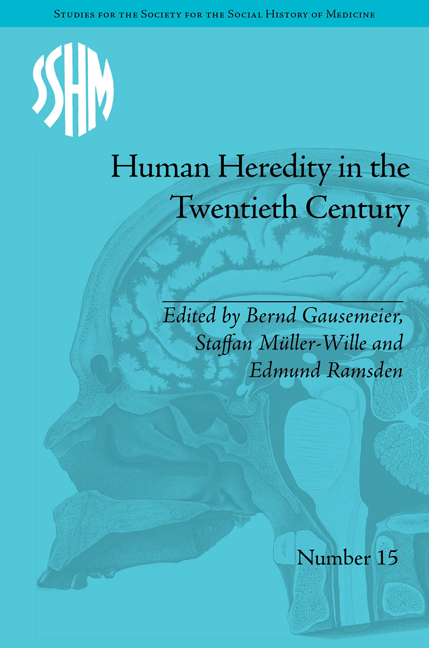Book contents
- Frontmatter
- Contents
- Acknowledgements
- List of Contributors
- List of Figures and Tables
- Introduction: Human Heredity in the Twentieth Century
- Part I Constructing Surveys of Heredity
- Part II Blood and Populations
- Part III Human Heredity in the Laboratory
- Part IV Understanding and Managing Disease
- Part V Reconstructing Discipline(s)
- 14 The Emergence of Genetic Counselling in the Federal Republic of Germany: Continuity and Change in the Narratives of Human Geneticists, c. 1968–80
- 15 Performing Anger: H. J. Muller, James V. Neel and Radiation Risk
- 16 The Struggle for Authority over Italian Genetics: The Ninth International Congress of Genetics in Bellagio, 1948–53
- Notes
- Index
16 - The Struggle for Authority over Italian Genetics: The Ninth International Congress of Genetics in Bellagio, 1948–53
from Part V - Reconstructing Discipline(s)
- Frontmatter
- Contents
- Acknowledgements
- List of Contributors
- List of Figures and Tables
- Introduction: Human Heredity in the Twentieth Century
- Part I Constructing Surveys of Heredity
- Part II Blood and Populations
- Part III Human Heredity in the Laboratory
- Part IV Understanding and Managing Disease
- Part V Reconstructing Discipline(s)
- 14 The Emergence of Genetic Counselling in the Federal Republic of Germany: Continuity and Change in the Narratives of Human Geneticists, c. 1968–80
- 15 Performing Anger: H. J. Muller, James V. Neel and Radiation Risk
- 16 The Struggle for Authority over Italian Genetics: The Ninth International Congress of Genetics in Bellagio, 1948–53
- Notes
- Index
Summary
Introduction
From 24 to 31 August 1953, the Ninth International Congress of Genetics was held in Bellagio, on the banks of Lake Como in Italy. Reflecting on the history of the Seventh International Congress of Genetics, Nikolai Krementsov observed:
congresses provide a vehicle for the advancement of local agendas, particularly for the scientists of the host country. National communities routinely use such congresses to enhance their disciplines' standing and visibility in the eyes of domestic patrons, which lead to sometimes quite fierce competition among national communities for the chance to host such a congress.
From this perspective, the Bellagio Congress was an expression of the developments in Italian genetics from the second half of the 1940s; from another, it triggered a further process of institutionalization.
The organization of the Bellagio Congress coincided with a period of extraordinary expansion in the activities of the three Italian professional geneticists: Adriano Buzzati-Traverso (1913–83), Claudio Barigozzi (1909–96) and Giuseppe Montalenti (1904–90). In 1948 Buzzati-Traverso and Barigozzi were appointed to the newly created chairs of genetics, in Pavia and Milan respectively; Montalenti had already obtained the first chair of genetics in Italy in 1944. Formal and developmental genetics of pseudotumours in Drosophila and cancer cytology were the main research focus of Barigozzi's group in Milan.
- Type
- Chapter
- Information
- Human Heredity in the Twentieth Century , pp. 217 - 228Publisher: Pickering & ChattoFirst published in: 2014



